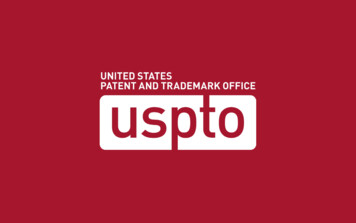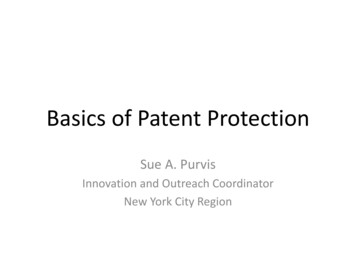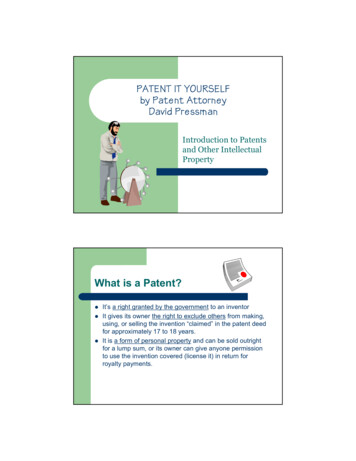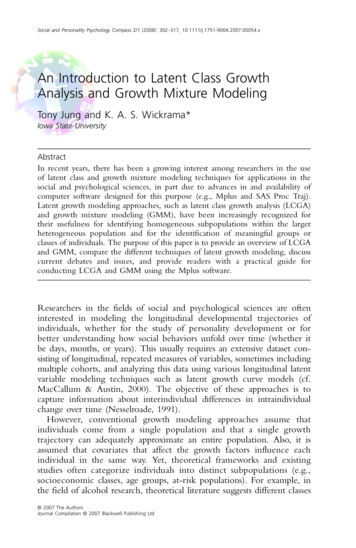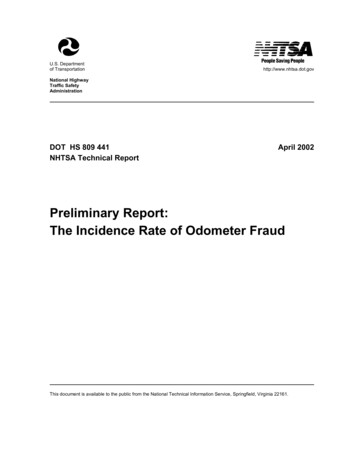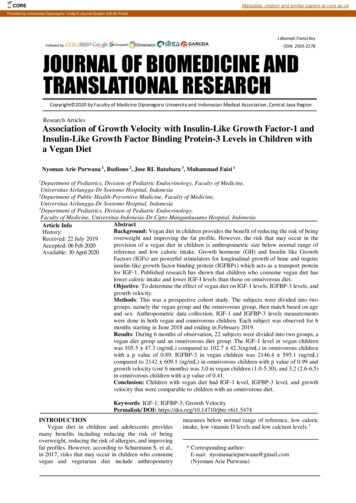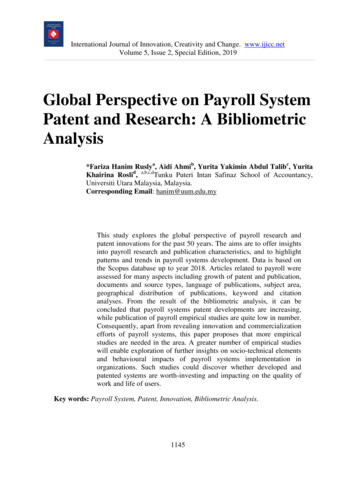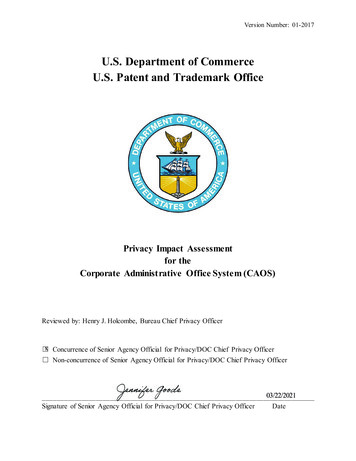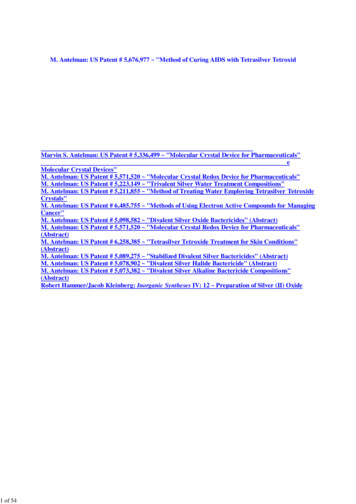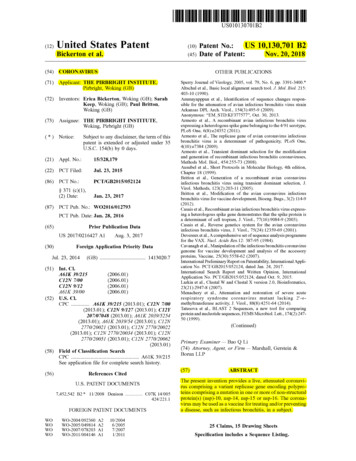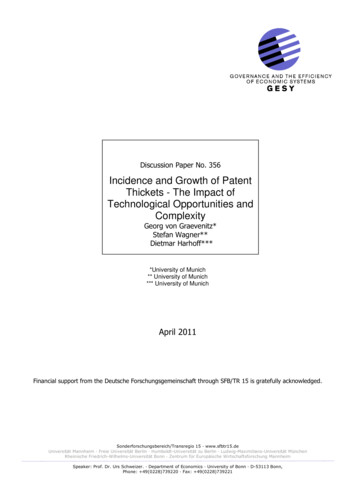
Transcription
Discussion Paper No. 356Incidence and Growth of PatentThickets - The Impact ofTechnological Opportunities andComplexityGeorg von Graevenitz*Stefan Wagner**Dietmar Harhoff****University of Munich** University of Munich*** University of MunichApril 2011Financial support from the Deutsche Forschungsgemeinschaft through SFB/TR 15 is gratefully acknowledged.Sonderforschungsbereich/Transregio 15 www.sfbtr15.deUniversität Mannheim Freie Universität Berlin Humboldt-Universität zu Berlin Ludwig-Maximilians-Universität MünchenRheinische Friedrich-Wilhelms-Universität Bonn Zentrum für Europäische Wirtschaftsforschung MannheimSpeaker: Prof. Dr. Urs Schweizer. Department of Economics University of Bonn D-53113 Bonn,Phone: 49(0228)739220 Fax: 49(0228)739221
Incidence and Growth of Patent Thickets - The Impactof Technological Opportunities and ComplexityGeorg von Graevenitz , Stefan Wagner†, Dietmar Harhoff‡April 7, 2011AbstractWe investigate incidence and evolution of patent thickets. Our empirical analysis is basedon a theoretical model of patenting in complex and discrete technologies. The model captures how competition for patent portfolios and complementarity of patents affect patenting incentives. We show that lower technological opportunities increase patenting incentives in complex technologies while they decrease incentives in discrete technologies.Also, more competitors increase patenting incentives in complex technologies and reducethem in discrete technologies. To test these predictions a new measure of the density ofpatent thickets is introduced. European patent citations are used to construct measures offragmentation and technological opportunity. Our empirical analysis is based on a panelcapturing patenting behavior of 2074 firms in 30 technology areas over 15 years. GMMestimation results confirm the predictions of our theoretical model. The results show thatpatent thickets exist in 9 out of 30 technology areas. We find that decreased technologicalopportunities are a surprisingly strong driver of patent thicket growth.JEL: L13, L20, O34.Keywords: Patenting, Patent thickets, Patent portfolio races, Complexity, TechnologicalOpportunities.Acknowledgements: We thank Sven Feldmann, David Ulph, Tomaso Duso, Reiko Aoki,Sadao Nagaoka, Rene Belderbos, Dirk Czarnitzki, Georg Licht, Mark Schankerman,Bronwyn Hall and Joachim Winter for comments. Vincenzo Denicolò and Konrad Stahlprovided detailed comments on the manuscript. Helmut Küchenhoff and Fabian Scheiplprovided feedback on the model. Participants at the 64th ESEM, the 15th Panel DataConference, the Knowledge for Growth Conference, the 2008 CRESSE Conference, the3rd ZEW conference on the Economics of Innovation and Patenting, the 2008 workshopof the SFB TR/15 in Gummersbach and at seminars at NUS, HKUST, Melbourne Business School, ETH Zurich, EPFL, Tokyo, Leuven and Ecole des Mines provided feedback.Bronwyn Hall supplied code to consolidate applicant names. This paper was written withthe support of the SFB Transregio 15 financed by the DFG. The usual disclaimer applies. Georg von Graevenitz, Ludwig Maximilians University, Munich School of Management, INNO-tec,Kaulbachstraße 45, D-80539, Munich, graevenitz@lmu.de†Stefan Wagner, Ludwig Maximilians University, Munich School of Management, INNO-tec, Kaulbachstraße45, D-80539, Munich, swagner@bwl.lmu.de‡Dietmar Harhoff, Ludwig Maximilians University, Munich School of Management, INNO-tec, Kaulbachstraße 45, D-80539, Munich, harhoff@lmu.de
1 IntroductionStrong increases in the level of patent applications have been observed at the United StatesPatent and Trademark Office (USPTO) (Kortum and Lerner, 1998, Hall, 2005a) and the European Patent Office (EPO) (von Graevenitz et al., 2007). These “patent explosions” poseserious challenges for existing patent systems and also for competition authorities.1Explanations for this shift in patenting behavior focus on changes in the legal environmentand management practices, the complexity of some technologies, greater technological opportunities and increased strategic behavior on the part of firms. While it has been shown thatmost of these factors play a role empirically, there are no explanations of patenting behaviorthat integrate the effects of these determinants.2 This paper provides such an integrative modeland an empirical test of its predictions. We introduce a new measure of complexity of blocking relationships, allowing us to quantify the extent of patent thickets. With this measure weshow that patent thickets exist in 9 of the 30 technology areas making up the patent system andare growing to include more firms. Our empirical results also reveal that patenting respondssurprisingly strongly to variation in technological opportunities.Kortum and Lerner (1998, 1999) investigated the explosion of patenting at the USPTOwhich began around 1984 (Hall, 2005a). By a process of elimination they argue that increasedpatenting mainly results from changed management practices making R&D more applied andraising the yield of patents from R&D. Kortum and Lerner (1998, 1999) and Hall and Ziedonis(2001) also explore whether enhanced fertility of R&D led to an increase in patent filings, butcannot find systematic evidence for this. Hall and Ziedonis (2001) provide evidence that thepatenting surge is a strategic response to an increased threat of hold-up specifically in complextechnologies in which products depend on the combination of large numbers of patents. Complexity of a technology implies that patents are natural complements, and therefore hold-uparises easily if patent ownership is dispersed (Shapiro, 2001, Ziedonis, 2004). Hall (2005a)also shows that the patenting surge is driven by firms whose main technologies are complex.Our model of patenting juxtaposes patenting incentives in complex and discrete technologies. In the model patenting incentives arise from the interaction of technological opportunity(fertility) and the complexity of technologies. To model the joint effect of these determinants of patenting, we posit a two dimensional matrix of technological opportunities and ofpatentable innovations within each such opportunity. We refer to the latter as facets. Firmschoose between pursuing new technological opportunities and deepening protection of specific opportunities by patenting of more facets. Analysis of the model shows that firms’ actions are strategic substitutes in discrete technologies but become strategic complements in1For extensive discussions of the policy questions surrounding current functioning of the patent systems inthe United States and in Europe refer to National Research Council (2004), Federal Trade Commission (2003),Jaffe and Lerner (2004), von Graevenitz et al. (2007) and Bessen and Meurer (2008).2Formal models of patenting abound, for a survey of this literature refer to Scotchmer (2005) or Galliniand Scotchmer (2002). Formal models of patenting in patent thickets do not attempt to span both complex anddiscrete technologies as we do here: Bessen (2004), Clark and Konrad (2008) and Siebert and von Graevenitz(2010). These models build on the patent race literature pioneered by Loury (1979), Lee and Wilde (1980),Reinganum (1989) and Beath et al. (1989).1
sufficiently complex technologies. In a complex technology firms patent less in response toincreasing technological opportunities and more if more other firms compete for patents. Botheffects result from strategic interaction of firms in a complex technology: greater technological opportunities reduce pressures on firms to defend their stake in existing technologies bypatenting heavily, whereas greater competition increases this pressure.Predictions derived from the model are tested using a comprehensive data set based onEPO patent data. It comprises information on patenting behavior between 1987 and 2002spanning complex and discrete technologies. We measure the complexity of blocking in atechnology area using information specific to European patents. Patent examiners at the EPOindicate which prior patents block or restrict the breadth of the patent application under review.We count how often three or more firms apply for mutually blocking patents within a threeyear period. This gives rise to a count of mutually blocking firm triples. The measure captures complex blocking relationships which arise even if patent ownership remains relativelyconcentrated. This new measure is validated by showing that greater incidence of complexblocking relationships is correlated with the classifications of technological complexity suggested by Cohen et al. (2000).Patenting behavior is known to be highly persistent, due to the long term nature of firms’R&D investment decisions. We control for the persistence of patenting by including a laggeddependent variable in the empirical model. The model is estimated using systems GMM estimators (Blundell and Bond, 1998, Arellano, 2003, Alvarez and Arellano, 2003) to controlfor endogeneity of the lagged dependent variable. Additionally, we treat measures of technological opportunity, complexity and fragmentation as predetermined. Results from OLS, fixedeffects and GMM regressions support our theoretical predictions. In particular, decreasingtechnological opportunities and increasing complexity lead to more patent filings. Thus, ourpaper suggests a new rationale for the rise of patent filings since the mid-1980s.The remainder of this paper is structured as follows. Section 2 provides a theoretical modelof patenting which explains firms’ patenting strategies. We derive three hypotheses from thismodel that are empirically testable. In Section 3 we describe our data set and the variableswe employ to analyze firms’ patenting behavior. As there is little cross industry evidence ofpatenting trends at the EPO, Section 4 provides a descriptive analysis of these trends, focusingparticularly on our own measure and alternative measures of complexity. Section 5 providesthe empirical model and results and Section 6 concludes.2 A Model of PatentingHere we present a model of patenting behavior. This model shows how technological opportunity and complexity of technology affect the levels of patenting set by firms. Technologicalopportunity and complexity are assumed to be fixed in the short- to medium term.3 First,3In the long run technological opportunity may be affected by firms’ patenting efforts. Unravelling thisquestion will require a separate study with data on firms’ R&D activities over a very long period.2
we motivate the model and discuss assumptions. Then, we provide a number of definitions.Next we solve the model, presenting several predictions. These underpin the empirical resultspresented in Sections 4 and 5 below.2.1MotivationThe following model captures patenting incentives in discrete and complex technologies. Wecharacterize how the degree of technological opportunity and the complexity of a technologydetermine the level of patenting of that technology.We recognize that the patent system covers a multitude of different technology areas.Within these we posit distinct technological opportunities that derive from separate researchefforts. Each technological opportunity consists of one or more patentable facets. Every facetcorresponds to a potential patent. Technologically related facets are grouped together in technological opportunities because they derive from the same knowledge and science base.The underlying model of R&D and of the patent office is kept as simple as possible: firmsselect how many technological opportunities to research and how many facets of each to seekto patent. Facets and opportunities are chosen randomly by each firm. Where more than oneapplicant applies for a facet, that is randomly assigned to one applicant. Patent allocation isthe sole function of the patent office in the model. These assumptions capture competitionbetween firms seeking to make enough applications to ensure that some result in grantedpatents. This model can be presented as a matrix of patents that firms compete to patent:TechnologyArea 1TechnologicalOpportunities OiPatentableFacets FiO1O2O3 F11F21F12F22TechnologyArea 2O1O2F31F11F32F12TechnologyArea 3 3F43F14F24F14F24F34F44 F1mF2mF3mF4mLevel ofComplexityO1Figure 1: Complexity and the number of patentable facets per technological opportunity.This figure shows different matrices corresponding to technology areas with growing levelsof complexity and varying levels of technological opportunity. Complexity increases with thenumber of facets. With higher complexity it is increasingly probable that ownership of patentsin a technological opportunity becomes dispersed. We assume that the value of owning patents3
in technological opportunities with more than one facet depends on the share of patents ineach technological opportunity that firms own. This captures the interdependence of patentsin complex technologies and the possibility for hold-up within them. In this model hold-uparises within technological opportunities but not between them.Consider two examples: first, one patent generally suffices for the applicant to protect anethical drug effectively against attempts to invent around the patent. This is the case of adiscrete technology in which each patent covers one technological opportunity. Second, lasertechnology is used in a very wide range of applications such as eye surgery (e.g. LASIK)or pollution monitoring and forestry management (LIDAR). This is the case of a complextechnology area within the field of optics.4 Each application of laser technology can be thoughtof as a technological opportunity requiring a range of different patentable inventions that arecombined in a functioning product. A product using laser technology will usually also embodysome patents relating to different technological areas outside of optics, but this is a point ourmodel abstracts from. Due to the complexity of the technology hold-up may arise: in thecase of LASIK there has was a string of court cases between VISX Inc. and Nidek Inc. after1998 regarding infringement of VISX patents on LASIK. The companies finally settled theirdisputes world wide in April of 2003.We do not explicitly model such hold-up or its resolution. The literature on patent thicketsshows that several institutional arrangements allow firms to disentangle overlapping propertyrights - these include licensing, patent pools, standard setting as well as litigation (Shapiro,2001, Scotchmer, 2005). There is some evidence that firms holding a large share of patentswithin a given technology benefit substantially from their patent portfolio and may be able toreduce the likelihood of hold-up (Grindley and Teece, 1997, Shapiro, 2001, Ziedonis, 2004).This is attributed to an increase in bargaining power. Additional patents also reduce marginallegal costs as the share of patents grows: firms with a large share of patents on a technologicalopportunity will need to cross-license or litigate less (Lanjouw and Schankerman, 2004).Our model abstracts from the link between patents and the product market, assuming onlythat the technological opportunities firms are patenting are valuable. In complex technologiespatents may be complements: then the value of the entire technology grows as more components of the technology are patented. The process of patenting is also modeled simply: oncefirms invest in R&D for a technological opportunity the number of facets they seek to patentis limited only by the costs of maintaining granted patents. The probability of obtaining agranted patent on a facet falls with the number of rivals also seeking to patent that facet.This model allows us to capture competition for patents in discrete technologies and incomplex technologies. As we show next the nature of competition depends on the complexityof a technology and the complementarity of facets in each opportunity.4To further clarify the definitions of opportunities, facets and technology areas we discuss the example ofLED technology at greater length in Appendix D.4
2.2AssumptionsWe study a setting in which a technology area is characterized by (O) technological opportunities each of which consists of patentable facets. A technological opportunity is an independentsource of profit to a firm and each facet is a separate patentable invention which is part of theopportunity. The total number of patentable inventions (facets) offered by a technological opportunity is F . Thus a technology area is discrete if F 1. We assume that:5All technological opportunities in a technology area are symmetrical; they offer thesame number of facets, and costs of R&D and of patenting are identical.(S)The total set of patentable inventions in a technology consists of Ω O F facets.As F grows the underlying technology grows more complex. If there is more technologicalopportunity, O grows. Variation in the two dimensions of the set of available patents Ω arisesfor different reasons. Current efforts in basic R&D open additional new opportunities in thefuture raising O. The number of facets which are patentable on a given opportunity dependsmainly on the nature of technology but also on institutional and legal factors.Each technological opportunity is associated with a maximal total value V (F ) and an actually attained value V (F̃ ). The attained value depends on the number of facets actually patentedby all firms F̃ , which may be less or equal to the number of available facets F . Firms appropriate a share s of the attained value by acquiring patents. To capture the complementarity ofinventions in complex technologies we assume that the value of the technological opportunityincreases in the number of facets of that opportunity patented by all firms F̃ :6V (0) 0 V 0 F̃and.(CI)There are N 1 firms active in a given technology area. Each can apply for patent protection for all facets of a technological opportunity. A firm’s strategy consists of the numberof opportunities ok (ok [0, O]) it invests in and the number of facets fk (fk [0, F ]) peropportunity which it seeks to patent. Subscripts index the firm. Each firm can only make onepatent application per facet and it can only patent in technological opportunities which it hasresearched . It trades off patenting more facets per opportunity and patenting in more differenttechnological opportunities. While patenting additional facets is assumed to be costless,7 amaintenance fee is payable (Ca ) on granted patents. Additionally, firms must undertake costlyR&D (Co ) on each technological opportunity they turn to. Finally, costs of coordinating sepa5Note that this assumption rules out aspects of complexity that may be quite important in practice. Thuswe rule out that some facets may belong to more than one technological opportunity, making patents on themparticularly valuable blocking patents. We leave this aspect of complexity for future work.6A similar assumption is made by Lerner and Tirole (2004).7We make this assumption in order to simplify the model, but it can be shown that it does not affect our resultsif patent filing costs are sufficiently low in comparison to the costs of maintenance. In practice, initial applicationand examination fees for patents are indeed much lower than post-grant translation and renewal fees, since mostpatent offices cross-subsidize the initial stages in order to encourage patent filing.5
rate research projects (Cc ) are generally viewed as significant in the literature (Roberts, 2004).To summarize:i Per opportunity a firm invests in, it faces costs of R&D: Co .ii Per granted patent a firm faces costs of maintaining that patent: Ca .iii The coordination of R&D on different technological opportunities imposes costs Cc (ok ).c 0.(F V C)Therefore, we assume that C okAs the number of facets per technological opportunity grows, so does the probability thatdifferent firms o
Bronwyn Hall and Joachim Winter for comments. Vincenzo Denicolo and Konrad Stahl provided detailed comments on the manuscript. Helmut Kuchenhoff and Fabian Scheipl provided feedback on the model. Participants at the 64th ESEM, the 15th Panel Data Conference, the Knowled
